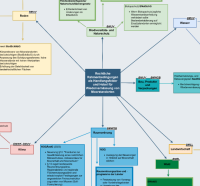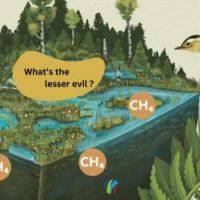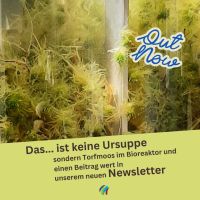News
April 2024
Launch of PaludiAllianz
by Dorothee Scheuch (comments: 0)
Companies for paludiculture

It was end of April, but the beginning for the Alliance of Pioneers: 14 large commercial enterprises from the paper, packaging, construction, insulation and wood-based material industries declared at a kick-off event in Berlin that they would test renewable, regional raw materials from wet peatlands in their production and integrate them wherever possible. According to the joint press release issued by the Michael Otto Environmental Foundation and the Succow Foundation, partners in the Greifswald Mire Centre, which launched the PaludiAllianz in the toMOORow initiative, the aim is to achieve rapidly growing demand for paludiculture in various sectors of the economy. Well-known companies are now among the founding members:
Interest in future paludiculture products in the construction sector has been expressed by prefabricated house manufacturer Bau-Fritz GmbH & Co. KG, the construction group STRABAG SE and OTTO WULFF Bauunternehmung GmbH and Sto SE & Co. KGaA. The companies toom Baumarkt and OBI Group Holding SE & Co. KGaA also consider biomass from paludiculture in the horticulture segment as a supplier of substrates. The retail and service company Otto (GmbH & Co. KG), LEIPA Group GmbH, the WEPA Foundation and, in the area of recyclables management, PreZero Stiftung & Co. KG with OutNature GmbH aim to make paper and packaging more sustainable by adding of paludiculture biomass. Procter & Gamble Service GmbH is involved in the area of consumer goods for household and cosmetics, as is Tengelmann Twenty-One KG with KiK Textilien and Non-Food in the retail sector.
“Development of scalable value chains with paludiculture biomass from rewetted peatlands in Germany in practical cooperation with economic players” (PaludiAllianz) is the detailed title of the project, for which Cem Özdemir, Federal Minister of Agriculture and Nutrition, handed over a funding decision of almost 1.8 million euros over the next three years at Kulturbrauerei in Berlin. As rewetting also offers effective natural climate protection, Federal Environment Minister Steffi Lemke was also a guest speaker at the event.
New GMC publication
by Dorothee Scheuch (comments: 0)
on peatland, law & rewetting

22/04/2024 "Legal framework conditions for the rewetting and use of peatlands - a mapping of fields of action and levers" is the full-length title of the new GMC publication. Above all, it provides a graphic overview of nine fields of action as well as the respective applicable legal bases and political strategies for rewetting and adapted peatland use in the Federal Republic of Germany. The focus is on the federal level. There are text boxes with suggestions as to which political levers could improve or accelerate peatland climate protection- The relevant ministries are conveniently assigned. The GMC publication is intended as a basis for further and more detailed legal analyses.
Methane and rewetting
by Dorothee Scheuch (comments: 0)
Explained in new film

17/04/2024 This film is troubleshooting this peatland question: What’s the lesser evil - drained peatlands emitting carbon dioxide (CO2) or rewetting causing methane (CH4) emissions? Find answers on:
Do peatlands emit methane?
Yes! Wet peatlands – intact and rewetted – release methane, and the climate-damaging greenhouse gas is also produced when rewetting formerly drained areas. Methane has a much stronger effect on the climate than carbon dioxide , but - remains in the atmosphere for comparably short time.
Then better avoid rewetting to prevent methane emissions?
What’s the better choice for climate protection?
Addressing the climate crisis requires reducing atmospheric concentrations of all three greenhouse gases relevant to peatlands (CH4, CO2, nitrous oxide (N2O)). Rewetting effectively reduces long-lived CO2 emissions from peatlands to zero effectively and quickly and is therefore always the right choice for climate protection.
Can we control methane in rewetted peatlands? Yes!
It is possible to minimise methane emissions by various measures as removing biomass ahead of rewetting, avoiding long-term flooding and rewetting gradually.
Want to know more about the role of methane, peatlands and rewetting?
Watch the entire film on YouTube. Find more information in our factsheet The role of methane in peatland rewetting.
Bioreactor, anniversary, three Ms & more ...
by Dorothee Scheuch (comments: 0)
Newsletter: new issue

10/04/2024 These topics don't go together? Yes, they do. Read in the new issue of our new issue of the Paludiculture Newsletter:
- what peat mosses have to do in a bioreactor,
- what the provisional failure of the Nature Restoration Law at the European Council now means for peatlands,
- how the 25-year-old concept of paludiculture is not old-fashioned at all, but should be celebrated today, and
- how researchers are scrutinizing a combination with a miserable reputation - namely mires, mosquitoes and malaria - in the Peene Valley.
Not only do we hope you enjoy reading this newsletter, we would also be delighted to receive feedback on it by e-mail to communication@greifswaldmoor.de.











